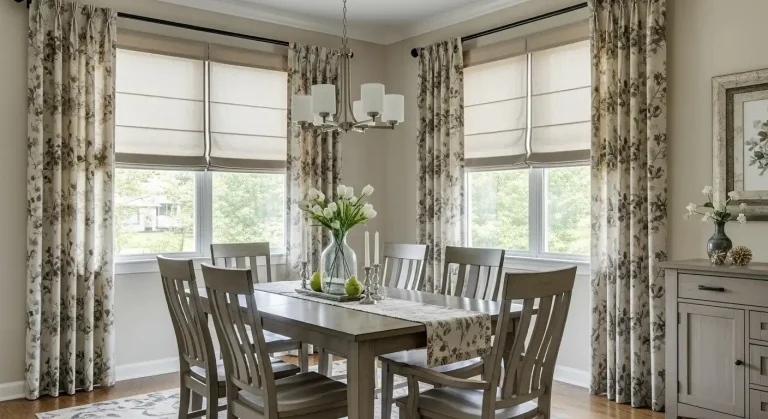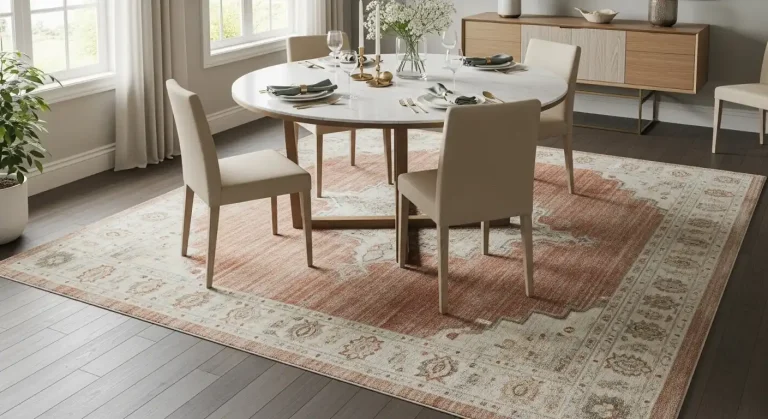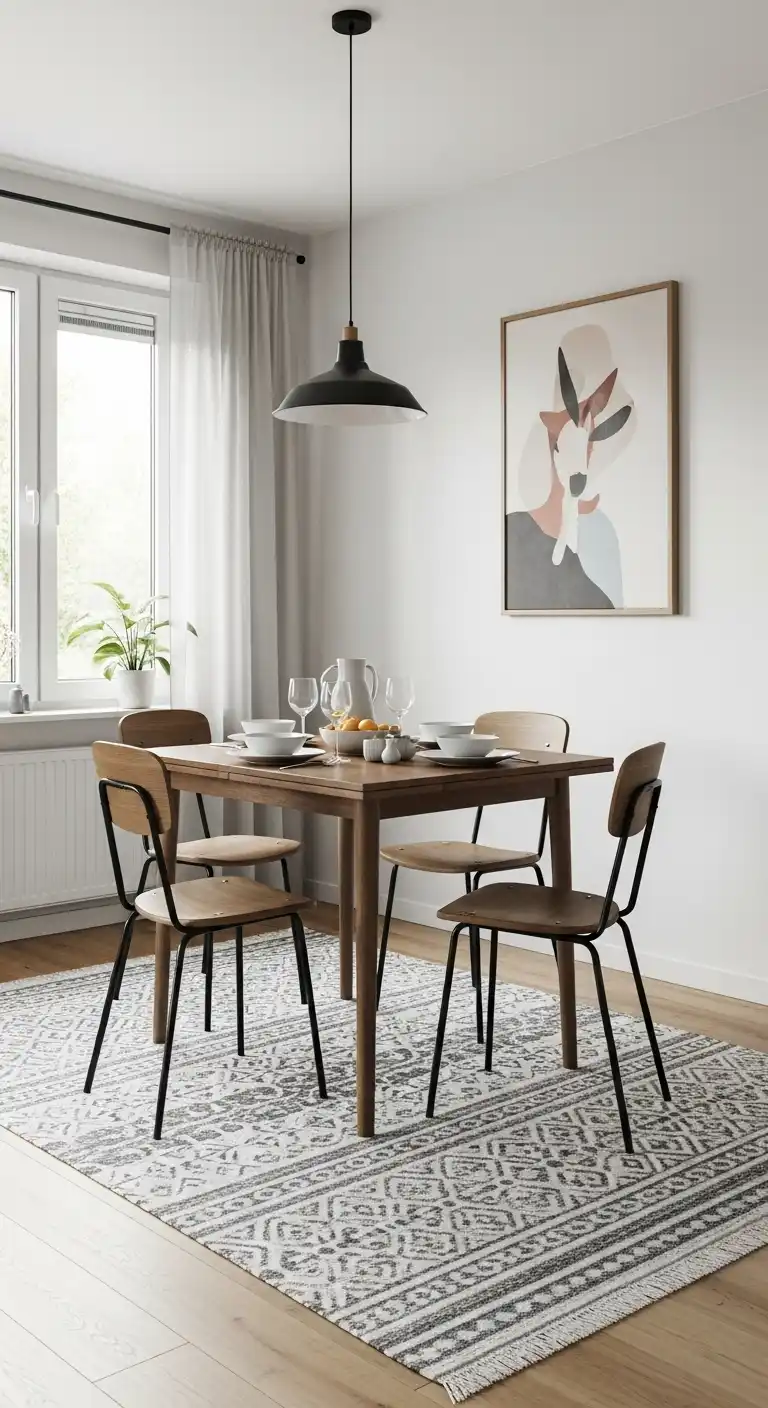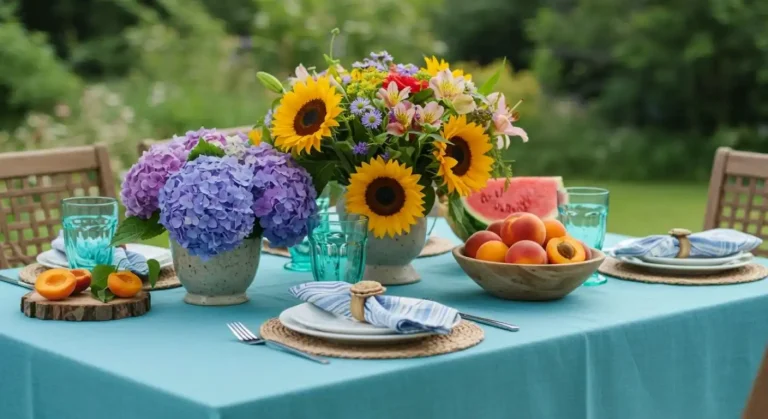How to Choose an Area Rug for a Dining Table: A Complete Guide
When choosing a dining room rug, consider size, material, and pile height to balance style and function. The right rug should fit all chairs when pulled out, suit your décor, and withstand daily use while enhancing comfort and protecting your floor.
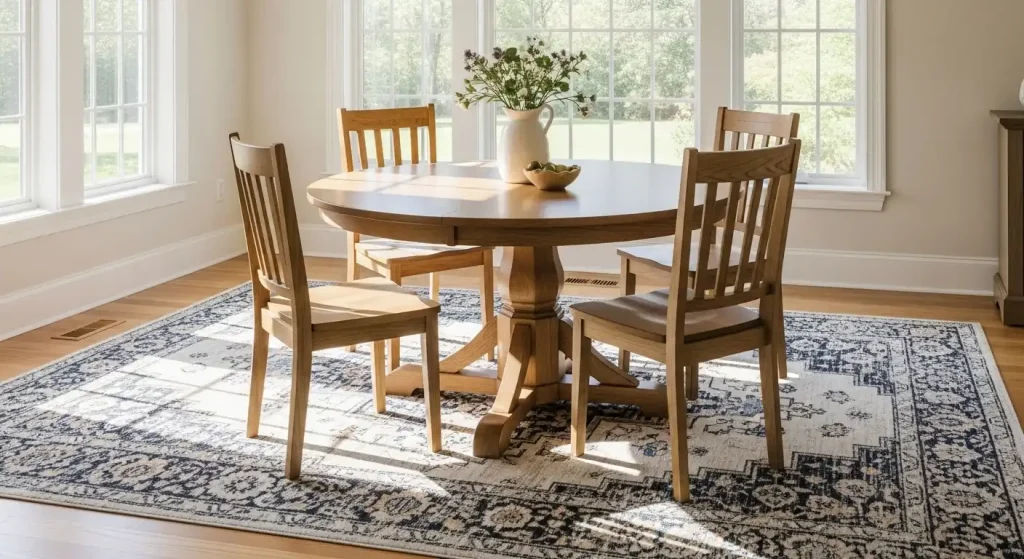
An area rug can completely transform the look and feel of your dining room.
It anchors the table, defines the space, and adds warmth, texture, and personality.
But choosing the right rug for under your dining table isn’t as simple as picking one you like—it’s about finding the perfect balance between size, shape, material, and style.
Christmas & Year-End Deals On Amazon !
Don’t miss out on the best discounts and top-rated products available right now!
*As an Amazon Associate, I earn from qualifying purchases.
In this guide, we’ll walk you through how to choose an area rug for a dining table so that it complements your décor, stands up to daily use, and makes your dining space more inviting.
Why a Rug Matters in the Dining Room
A dining room rug does more than add style—it creates a visual boundary for the dining area, especially in open-concept layouts.
It also protects your flooring from scratches, spills, and chair movement.
In smaller spaces, a rug can make the dining area feel more defined and cozy.
In larger rooms, it helps tie together the table, chairs, and surrounding décor into one cohesive look.
If you’re working with a small dining room, a rug can be a clever way to add depth and texture without overwhelming the space (see tips for small dining spaces here).
Get the Size Right
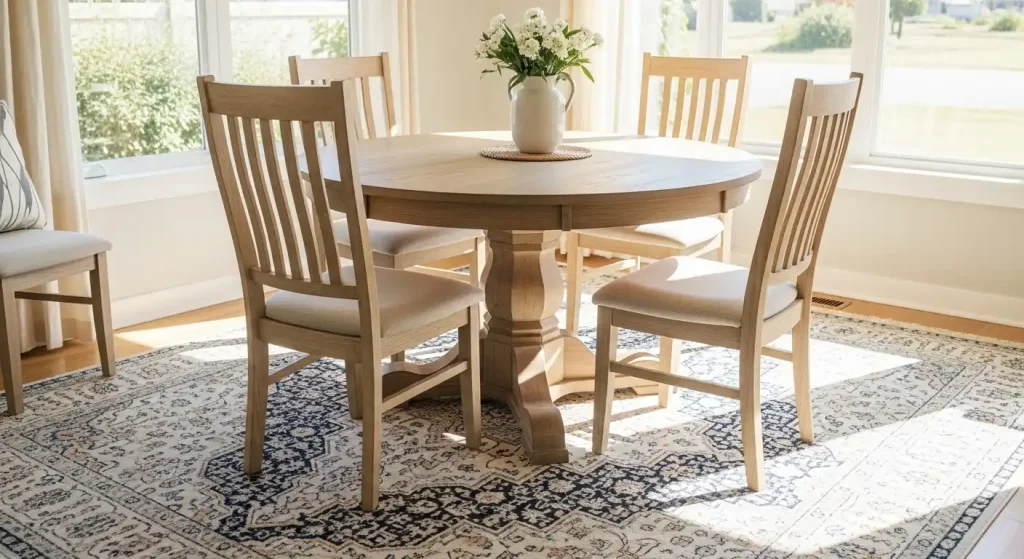
The most important rule for a dining room rug: it should be large enough for all chairs to sit comfortably on it—even when pulled out.
General sizing guidelines:
- For a 4–6 seater table: Look for a rug around 8′ x 10′ (or at least 60″ x 96″)
- For a larger 8–10 seater table: Aim for 9′ x 12′ or bigger
- Round tables: Choose a rug that extends at least 24 inches beyond the table’s edge on all sides
This extra space prevents chair legs from catching on the rug edge, which can be both annoying and unsafe.
If you’re unsure, measure your table and add at least 48 inches to both the length and width to find your ideal rug size.
You can also refer to this rug size guide for different dining styles.
Match the Rug Shape to the Table
While it’s not a strict rule, matching the rug shape to your dining table often creates the most harmonious look.
- Rectangular tables → Rectangular rugs
- Round tables → Round rugs
- Square tables → Square or round rugs
A round rug under a round table feels balanced and intentional, while a rectangular rug under a long table elongates the space.
If your dining table is oval, you can choose either a rectangular or oval rug depending on your room’s layout.
Choose the Right Material
Dining rooms are high-traffic areas prone to spills, so durability is key.
Christmas & Year-End Deals On Amazon !
Don’t miss out on the best discounts and top-rated products available right now!
*As an Amazon Associate, I earn from qualifying purchases.
Best rug materials for dining rooms:
- Wool – Naturally stain-resistant, durable, and soft underfoot
- Polypropylene – Affordable, easy to clean, and great for families
- Flatweave cotton or jute – Casual, textured, and easy to shake out crumbs
- Indoor-outdoor rugs – Perfect for messy eaters or homes with kids and pets
Avoid high-pile or shag rugs, as they trap crumbs and are harder to clean.
Flatweave or low-pile rugs are the most practical choice for easy maintenance.
If you love the cozy look of natural fibers, consider layering a jute rug with a smaller patterned rug on top, similar to how it’s done in farmhouse dining room designs.
Pick Colors and Patterns That Work for You
When deciding on rug colors and patterns, think about your dining room’s existing palette and style.
For a timeless look:
Neutral tones like beige, gray, or ivory create a versatile backdrop and work well in transitional dining rooms (see transitional style ideas here).
For a bold statement:
Go for vibrant patterns or rich colors to make the rug the focal point. This works especially well if your walls and furniture are neutral.
For hiding stains:
Patterned rugs are your best friend—they disguise crumbs and spills better than solid colors.
Coordinate with Your Dining Room Style
Your rug should complement—not compete with—your dining room style.
- Farmhouse: Go for distressed patterns, natural fibers, or braided rugs in earthy tones
- Modern: Choose geometric designs, bold contrasts, or monochrome palettes (modern dining room inspiration here)
- Boho: Layer colorful, eclectic rugs for a relaxed, lived-in vibe (boho dining ideas here)
- Formal: Opt for rich textures, traditional Persian or Oriental designs, or rugs with elegant borders (formal dining tips here)
Matching your rug style to your overall décor ensures a cohesive look.
Think About Maintenance
Even the most beautiful rug won’t be practical if it’s a nightmare to clean.
Maintenance tips:
- Choose stain-resistant materials or apply a protective rug spray
- Vacuum regularly to prevent crumbs from embedding in fibers
- Spot-clean spills immediately to avoid stains
- Rotate the rug every 6–12 months for even wear
For busy households, indoor-outdoor rugs or washable rugs are a smart choice—they can be hosed down or machine-washed when needed.
Christmas & Year-End Deals On Amazon !
Don’t miss out on the best discounts and top-rated products available right now!
*As an Amazon Associate, I earn from qualifying purchases.
Layering Rugs for Style and Function
Layering rugs can add depth and texture to your dining space.
For example, place a large neutral jute rug underneath and layer a patterned flatweave rug on top.
This not only enhances the style but also makes it easier to swap out the top rug for seasonal changes.
Layering works particularly well in cozy dining spaces (see cozy dining ideas here).
Rugs in Small Dining Rooms
If your dining room is small, you might worry that a rug will make it feel cramped.
The trick is to choose a rug that’s proportionate to the space and keeps sightlines open.
Light-colored rugs, subtle patterns, and low-pile textures help maintain an airy feel.
A round rug can soften the edges of a small room and create better flow (more small dining room tips here).
Seasonal Rug Swaps
Changing your rug seasonally can refresh your dining room without a full makeover.
- Spring/Summer: Light, breathable materials like cotton or jute in soft, fresh colors
- Fall/Winter: Richer tones, wool blends, or layered rugs for warmth
Pair your seasonal rug changes with updated table centerpieces (see centerpiece ideas here) or table linens (tablecloth inspiration here) for a coordinated look.
Placement Tips for a Polished Look
Once you’ve chosen the perfect rug, proper placement is key.
- Center the rug under the dining table so it’s evenly spaced on all sides
- Ensure all chair legs remain on the rug, even when pulled out
- In open layouts, align the rug with architectural elements like ceiling beams or pendant lights for balance
If your dining area is part of a larger open concept space (styling ideas here), the rug will help define the zone visually.
Christmas & Year-End Deals On Amazon !
Don’t miss out on the best discounts and top-rated products available right now!
*As an Amazon Associate, I earn from qualifying purchases.
Budget Considerations
Rugs come in a wide range of prices.
While it’s tempting to splurge, remember that dining room rugs are prone to spills and wear.
If you entertain often or have kids and pets, opt for a mid-range, durable rug that you won’t stress over if it gets stained.
Save the investment rugs for lower-traffic areas.
Final Checklist Before Buying
Before you click “add to cart,” run through this quick checklist:
- Size accommodates all pulled-out chairs
- Shape complements your table
- Material is durable and easy to clean
- Color/pattern suits your style and hides stains
- Works with your existing dining room décor
By following these steps, you’ll find a rug that’s both beautiful and functional—one that enhances your dining experience for years to come.
Final Thoughts
Knowing how to choose an area rug for a dining table is about balancing style, comfort, and practicality.
The right rug will ground your dining space, protect your floors, and make every meal feel more inviting.
Whether your style leans farmhouse, modern, transitional, or eclectic, there’s a perfect rug out there for you.
And with the right size, material, and design, you can enjoy a dining room that’s as functional as it is beautiful.
For more inspiration, explore our guides on best dining rugs for different styles, farmhouse dining room ideas, and creating a cozy dining space.
Christmas & Year-End Deals On Amazon !
Don’t miss out on the best discounts and top-rated products available right now!
*As an Amazon Associate, I earn from qualifying purchases.


